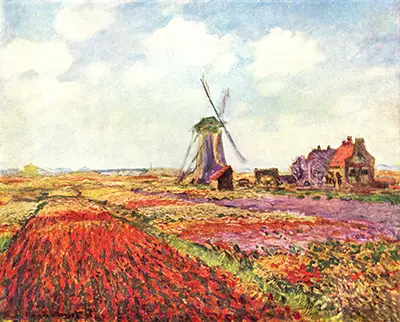In 1886, Claude Monet painted the fabulous tulip fields painting we all know and love today. For Claude Monet, painting this type of painting was nothing new, but the way the tulips were organised into colours and separated provided an opportunity to paint something that would of looked out of the ordinary to fans of his work outside Holland itself.
The Tulip Fields were not the only landscape he explored. He often created what were known as 'plein-air' landscape paintings using canals or lakes to explore the reflection of water. His first exploration into the effect of light on snow was in The Magpie which would of been painted in between 1868 and 1869. He also made use of water lilies to explore the ways the light reflects on water, and his water lilies series have become one of his most well known works.
Although a lot of critics initially panned Monet, his artwork inspired a lot of people. The French impressionist movement was undoubtedly created by him, and many followed in his footsteps.
Mary Cassatt came to Paris in 1866 and formed a close friendship with Degas, who was also a prominent French impressionist along side Monet. It is said she was influenced by impressionism.
Impressionism can be said to be one of the main influences of modern art, and the style of artists like Rothko show influences from artists like Monet in their work. Van Gogh and Claude Monet both have a lot of similarities, although neither influenced the other due to the fact they were painting at the same time.
Both faced very comparable challenges being around the first impressionists of their time. Although impressionism has a large following now, and has influenced more modern art styles, at the time, it was discredited by more traditional artists. At the time, artists like Monet and Van Gogh were seen as unruly, and rather than have their talent recognized for what it is, they were often chided for not having any talent.
Claude Monet was the founder of the French impressionist movement. Born in Paris in 1840, he was surrounded by a culture that fostered his thirst for the arts. His Mother herself was a singer, and often encouraged Monet to drive his passion for art forward. When he was younger, he was well known around Paris as caricature artist. For all of twenty francs, Parisians could own an early Monet.
After living in Normandy for some time with his parents, Monet moved back to Paris to concentrate on his art. In 1861 Monet was stationed in Algeria with the army, where he continued to pursue his passion by painting Kasbah scenes. His wealthy Father could of bought him out of his obligation to be in the army, but refused to do so when the younger Monet refused to give up painting.
In 1872, Monet painted Impression, sunrise, which gave birth to the French impressionist style. Although he constantly met with criticism from conservative artists and others in the art world, he stayed true to his style and painted some of the world famous paintings we have all come to know and love today.
Due to his French upbringing and heritage, Monet usually painted landscapes from the French countryside. Tulip Field was one of the first paintings by Monet that focussed on Holland in particular. Due to his impressionist style, Monet faced the challenge of depicting the regimented planting of the tulips in a less formal style.
Claude Monet was passionate about impressionism interpreting the artists view of the world, instead of painting it just like a photograph.
Monet loved painting landscapes, and he often painted these on his travels. One thing Monet especially liked focussing on was the effect of sunlight and shade on his subjects and landscapes. He explored this in Woman in a Garden which was painted in 1867.


